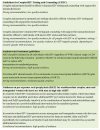Advances in HIV prevention for serodiscordant couples
- PMID: 25145645
- PMCID: PMC4267973
- DOI: 10.1007/s11904-014-0225-9
Advances in HIV prevention for serodiscordant couples
Abstract
Serodiscordant couples play an important role in maintaining the global HIV epidemic. This review summarizes biobehavioral and biomedical HIV prevention options for serodiscordant couples focusing on advances in 2013 and 2014, including World Health Organization guidelines and best evidence for couples counseling, couple-based interventions, and the use of antiviral agents for prevention. In the past few years, marked advances have been made in HIV prevention for serodiscordant couples and numerous ongoing studies are continuously expanding HIV prevention tools, especially in the area of pre-exposure prophylaxis. Uptake and adherence to antiviral therapy remains a key challenge. Additional research is needed to develop evidence-based interventions for couples, and especially for male-male couples. Randomized trials have demonstrated the prevention benefits of antiretroviral-based approaches among serodiscordant couples; however, residual transmission observed in recognized serodiscordant couples represents an important and resolvable challenge in HIV prevention.
References
-
-
Jiwatram-Negron T, El-Bassel N. Systematic Review of Couple-Based HIV Intervention and Prevention Studies: Advantages, Gaps, and Future Directions. AIDS Behav. 2014 Jul 2; 2014, epub ahead of print. ** This systematic review identified 27 biobehavioral interventions for serodiscordant couples. Thirteen studies focused on psycho-educational skills building, 13 studies focused on CHTC for heterosexual couples and one study focused on medication adherence for heterosexual and MSM couples.
-
-
- Burgener A, Sainsbury J, Plummer FA, Ball TB. Systems biology-based approaches to understand HIV-exposed uninfected women. Curr HIV/AIDS Rep. 2010;7:53–59. - PubMed
-
- Persson A. Notes on the concepts of ‘serodiscordance’ and ‘risk’ in couples with mixed HIV status. Glob Public Health. 2013;8:209–220. - PubMed
-
- Bunnell RE, Nassozi J, Marum E, Mubangizi J, Malamba S, Dillon B, et al. Living with discordance: knowledge, challenges, and prevention strategies of HIV-discordant couples in Uganda. AIDS Care. 2005;17:999–1012. - PubMed
-
-
Chemaitelly H, Cremin I, Shelton J, Hallett TB, Abu-Raddad LJ. Distinct HIV discordancy patterns by epidemic size in stable sexual partnerships in sub-Saharan Africa. Sex Transm Infect. 2012;88:51–57. * Estimates HIV infection in stable partnerships in 20 countries in sub-Saharan Africa. Percent of serodiscordant partnerships: in concentrated epidemics, 0 to 6%; in generalized epidemics, 9 to 17%. Proportion of HIV-positive persons with negative partners: in high HIV prevalence areas, about half, in low prevalence settings, as high as 75%.
-
Publication types
MeSH terms
Substances
Grants and funding
LinkOut - more resources
Full Text Sources
Other Literature Sources
Medical
Miscellaneous


